Cholinergic agonists act at the same site as the neurotransmitter acetylcholine (ACh) and increase the activity of the ACh receptor sites throughout the body.
These receptor sites are found throughout the body so their stimulation produces similar effects when parasympathetic nervous system is activated. Thus, they are also called as parasympathomimetics.
Cholinergic agonists can either be direct- or indirect-acting cholinergic agonists. Under indirectly-acting cholinergic agonists, there are agents for Alzheimer’s and Myasthenia Gravis.
Table of Contents
- Cholinergic Agonists: Generic and Brand Names
- Disease Spotlight: Alzheimer’s Disease and Myasthenia Gravis
- Direct-acting Cholinergic Agonists
- Indirect-acting Cholinergic Agonists
- Nursing Considerations for Cholinergic Agonists
- Practice Quiz: Cholinergic Agonists
- Recommended Resources
- See Also
- References and Sources
Cholinergic Agonists: Generic and Brand Names
Here is a table of commonly encountered cholinergic agonists, their generic names, and brand names:
- Direct-acting Cholinergic Agonists
- bethanechol (Duvoid, Urecholine)
- carbachol (Miostat)
- cevimeline (Evoxac)
- pilocarpine (Salagen)
- Indirect-acting Cholinergic Agonists
- Agents for Myasthenia Gravis
- ambenonium (Mytelase)
- edrophonium (Reversal)
- neostigmine (Prostigmin)
- pyridostigmine (Mestinon)
- Agents for Alzheimer’s Disease
- donepezil (Aricept)
- galantamine (Razadyne)
- rivastigmine (Exelon)
- tacrine (Cognex)
- Agents for Myasthenia Gravis
Disease Spotlight: Alzheimer’s Disease and Myasthenia Gravis
- Direct-acting cholinergic agonists are usually used for treatment of neurogenic bladder atony in children, relieve pressure on glaucoma patients, and treatment of symptoms of dry mouth in patients with Sjogren’s syndrome.
- Indirect-acting cholinergic agents are used for myasthenia gravis and Alzheimer’s disease. Myasthenia gravis is a chronic muscular disease caused by defect in neuromuscular transmission. It is thought to be an autoimmune disease in which antibodies to own ACh receptors are made. As fewer receptor sites become available, patients begin to have progressive weakness and lack of muscle control. On the other hand, Alzheimer’s disease is a progressive disorder of neural degeneration leading to marked loss of memory and the ability to carry on activities of daily living.
Direct-acting Cholinergic Agonists
- Direct-acting cholinergic agonists are similar to Ach and react directly with receptor sites to cause the same reaction if Ach has stimulated the receptor sites.
- Common examples include bethanechol and pilocarpine.
Therapeutic Action
The desired and beneficial actions of direct-acting cholinergic agonists are as follows:
- Direct-acting cholinergic agonists occupy receptor sites for ACh on the membranes of the effector cells causing increased stimulation.
- Effects include slowed heart rate and decreased myocardial contractility, vasodilation, bronchoconstriction and increased bronchial mucus secretion, increased GI activity and secretions, increased bladder tone, relaxation of GI and bladder sphincters, and pupil constriction.
Indications
Direct-acting cholinergic agonists are indicated for the following medical conditions:
- Direct-acting cholinergic agonists are systematically used as agents to increase bladder tone, urinary excretion, and GI secretions. As ophthalmic agents, they can induce miosis to relieve increased intraocular pressure in patients with glaucoma.
- Bethanechol has specific affinity for the cholinergic receptors in the urinary bladder and is used to treat non-obstructive postoperative and postpartum urinary retention to treat neurogenic bladder atony. It directly increases detrusor muscle tone and relaxes the sphincters to improve bladder emptying.
- Carbachol is an ophthalmic agent used to induce miosis or pupil constriction. It can relieve the increased intraocular pressure of glaucoma.
- Cevimeline and pilocarpine bind to muscarinic receptors throughout the body and are used to increase secretions in the mouth and GI tract and relieve symptoms of dry mouth. They are approved for use in adults and are given three times a day, often with meals.
Here are some important aspects to remember for indication of cholinergic agonists in different age groups:
Children
- They are at greater risk for complications related to use of these drugs, i.e. GI upset, diarrhea, increased salivation (leading to choking), and loss of bowel and bladder control.
- Bethanechol is approved for treatment of neurogenic bladder in children older than 8 years of age.
- Neostigmine and pyridostigmine are used in the control of myasthenia gravis and for reversal of neuromuscular junction blocker effects in children. Edrophonium is used for diagnosis of myasthenia gravis only.
Adults
- Adults should be cautioned of these drugs’ adverse effects (e.g. dizziness, GI upset, urinary urgency). They should not be allowed to operate machines.
- Use of these drugs among pregnant and lactating women is only justified if benefits outweigh the risks.
Older adults
- Dose adjustment is needed as this age group is also more susceptible to drug side effects.
- They are more likely to have toxic levels of the drug because of renal or hepatic impairments.
Pharmacokinetics
Here are the characteristic interactions of direct-acting cholinergic agonists and the body in terms of absorption, distribution, metabolism, and excretion:
| Route | Onset | Peak | Duration |
| Oral | 30-90 min | 60-90 min | 1-6 h |
| T1/2: unknown Metabolism: unknown Excretion: unknown |
Contraindications and Cautions
The following are contraindications and cautions for the use of direct-acting cholinergic agonists:
- Allergy to any component of the drug. To prevent hypersensitivity reaction
- Bradycardia, hypotension, vasomotor instability, and coronary artery disease. Can be made worse by the cardiac- and cardiovascular-suppressing effects of the parasympathetic system.
- Peptic ulcer, intestinal obstruction, or recent GI surgery. Can be negatively affected by the GI-stimulating effects of the parasympathetic nervous system.
- Bladder obstruction. Aggravated by the stimulatory effects on the bladder.
- Epilepsy and parkinsonism. Affected by the stimulation of ACh receptors in the brain.
- Hepatic or renal dysfunction. Drugs used to treat Alzheimer’s are metabolized in the liver.
- Pregnancy and lactation. Potential adverse effects on the fetus or neonate.
Adverse Effects
Use of direct-acting cholinergic agonists may result to these adverse effects:
- CV: bradycardia, heart block, hypotension, cardiac arrest
- GI: nausea, vomiting, cramps, diarrhea, increased salivation
- GU: urinary urgency
- Others: flushing, increased sweating
- WARNING Pilocarpine and cevimeline may cause swallowing difficulties.
Interactions
The following are drug-drug interactions involved in the use of direct-acting cholinergic agonists:
- Acetylcholinesterase inhibitors. Increased risk of cholinergic effects.
- NSAIDs. Increased risk of GI bleeding
Indirect-acting Cholinergic Agonists
- Indirect-acting cholinergic agonists do not react directly with ACh receptor sites; instead, they react chemically with acetylcholinesterase (enzyme breaking down acetylcholine) in the synaptic cleft to prevent it from breaking down ACh.
- These drugs can irreversibly or reversibly bind to acetylcholinesterase. The ones that bind irreversibly are not used therapeutically; they are being developed as nerve gas to be used as weapons. The antidote is pralidoxime.
- The reversible indirect-acting cholinergic agonists fall into two main categories: agents used to treat myasthenia gravis; and agents used to treat Alzheimer’s disease.
Therapeutic Action
The desired and beneficial actions of indirect-acting cholinergic agonists are as follows:
- Indirect-acting cholinergic agonists react with the enzyme acetylcholinesterase to increase the stimulation of the ACh receptor sites. Consequently, ACh remains the area and accumulates, stimulating ACh receptors for a longer period of time than normally expected.
- Agents for myasthenia gravis increase the levels of ACh, facilitating transmission at the neuromuscular junction.
- Agents for Alzheimer’s disease cause elevated ACh levels in the cortex, which slows the neuronal degradation of Alzheimer’s disease.
Indications
Indirect-acting cholinergic agonists are indicated for the following medical conditions:
- Treatment of myasthenia gravis, antidote for nondepolarizing neuromuscular junction blockers, increased survival after exposure to nerve gas
- Treatment of mild to moderate Alzheimer’s disease
Pharmacokinetics
Here are the characteristic interactions of agents for myasthenia gravis and the body in terms of absorption, distribution, metabolism, and excretion:
| Route | Onset | Peak | Duration |
| Oral | 35-45 min | – | 3-6 h |
| IM | 15 min | – | 3-6 h |
| IV | 5 min | – | 3-6 h |
| T1/2: 1.9-3.7 h Metabolism: liver Excretion: urine |
Here are the characteristic interactions of agents for Alzheimer’s disease and the body in terms of absorption, distribution, metabolism, and excretion:
| Route | Onset | Peak | Duration |
| Oral | Varies | 2-4 h | – |
| T1/2: 70 h Metabolism: liver Excretion: urine |
Contraindications and Cautions
The following are contraindications and cautions for the use of indirect-acting cholinergic agonists:
- Allergy to any component of the drug. To prevent hypersensitivity reaction
- Bradycardia, intestinal/urinary tract obstruction. Can be exacerbated by the stimulation of cholinergic receptors
- Pregnancy. Uterus could be stimulated and labor induced
- Asthma, coronary disease, peptic ulcer, arrhythmias, epilepsy, parkinsonism. Can be exacerbated by effects of parasympathetic stimulation
- Hepatic or renal dysfunction. Can interfere with metabolism and excretion of drugs
Adverse Effects
Use of indirect-acting cholinergic agonists may result to these adverse effects:
- CNS: miosis, blurred vision, headaches, dizziness, drowsiness
- CV: bradycardia, heart block, hypotension, cardiac arrest
- GI: nausea, vomiting, cramps, diarrhea, increased salivation, involuntary defecation
- GU: urinary urgency
- Others: flushing, increased sweating
Interactions
The following are drug-drug interactions involved in the use of indirect-acting cholinergic agonists:
- NSAIDs. Increased risk of GI bleeding
- Theophylline. Increased levels if combined with tacrine.
Nursing Considerations for Cholinergic Agonists
Here are important nursing considerations when administering cholinergic agonists:
Nursing Assessment
These are the important things the nurse should include in conducting assessment, history taking, and examination:
- Assess for contraindications or cautions (e.g. history of allergy to drug, GI obstruction, pregnancy or lactation status, etc.) to avoid adverse effects.
- Establish baseline physical assessment to monitor for any potential adverse effects.
- Assess orientation, affect, reflexes to monitor CNS drug effects.
- Assess vital signs, especially pulse and blood pressure to monitor for possible excess stimulation of the cardiac system.
- Assess abdomen, auscultating for bowel sounds and palpating for distention.
- Monitor intake and output, noting any complaints of urinary urgency to monitor for drug effects on the urinary system.
Nursing Diagnosis and Care Planning
Here are some of the nursing diagnoses that can be formulated in the use of this drug for therapy:
- Acute pain related to GI effects
- Decreased cardiac output related to CV effects
- Impaired urinary elimination related to effects on the bladder
Implementation with Rationale
These are vital nursing interventions done in patients who are taking cholinergic agonists:
- Administer oral drug on empty stomach to decrease nausea and vomiting.
- If drug is given intravenously, administer slowly to avoid severe cholinergic effects.
- Monitor patient response closely (e.g., blood pressure, ECG, urine output) to arrange to adjust dose accordingly to ensure the most benefit.
- Maintain a cholinergic-blocking drug on standby such as atropine to use as an antidote for excessive doses of cholinergic drugs.
- Discontinue drug if excessive salivation, diarrhea, emesis, or frequent urination becomes a problem to decrease the risk of severe adverse reactions.
- Provide safety precautions if the patient reports poor visual acuity in dim light to prevent injury.
- Provide comfort measures (e.g., quiet room, support and relaxation measures) to help patient cope with drug effects.
- Provide patient education about drug effects and warning signs to report to enhance knowledge about drug therapy and promote compliance.
Evaluation
Here are aspects of care that should be evaluated to determine effectiveness of drug therapy:
- Monitor patient response to therapy (improvement in condition being treated).
- Monitor for adverse effects (e.g. GI upset, CNS changes, CV changes).
- Evaluate patient understanding on drug therapy by asking patient to name the drug, its indication, and adverse effects to watch for.
- Monitor patient compliance to drug therapy.
Practice Quiz: Cholinergic Agonists
Here are some practice questions for this study guide. Please visit our nursing test bank page for more NCLEX practice questions.
1. The following are true about cholinergic agonists, except:
A. These drugs exert their effect by mobilizing the acetylcholine into their receptors found throughout the body.
B. Some of their effects include vasodilation, bronchoconstriction, and bladder relaxation.
C. Ophthalmic agents can induce miosis or pupil constriction.
D. Edrophonium is used for diagnosis of myasthenia gravis only.
1. Answer: A. These drugs exert their effect by mobilizing the acetylcholine into their receptors found throughout the body.
Cholinergic agonists act at the same site as the neurotransmitter acetylcholine (ACh) and increase the activity of the ACh receptor sites throughout the body. They do not mobilize acetylcholine into their receptors.
2. All of the following are direct-acting cholinergic agonists, except:
A. Pilocarpine
B. Neostigmine
C. Carbachol
D. Cevimeline
2. Answer: B. Neostigmine
It is an agent for myasthenia gravis and is therefore an indirect-acting cholinergic agonist.
3. This drug is usually indicated for postoperative and postpartum urinary retention as well as bladder atony.
A. carbachol
B. bethanechol
C. tacrine
D. pyridostigmine
3. Answer: B. bethanechol
This drug has specific affinity for receptors in the urinary bladder.
4. Which of the following is an indication for withholding indirect-acting cholinergic agonists?
A. Visual acuity of 20/150
B. Blood pressure of 140/90 mmHg
C. GFR of 30 mL/hour
D. Adult heart rate of 55 beats per minute
4. Answer: D. Adult heart rate of 55 beats per minute
It can be exacerbated by the parasympathetic effects of the drug
5. A patient on neostigmine complained of frequent diarrhea and salivation. Which is the best nursing action for this situation?
A. Educate client about drug therapy to alleviate anxiety as these are expected drug effects.
B. Withhold the dose of the drug and refer to physician.
C. Arrange for increasing the dose of the drug as it is not effective.
D. Document patient response and endorse accordingly for bedside care.
5. Answer: B. Withhold the dose of the drug and refer to physician.
Discontinue drug if excessive salivation, diarrhea, emesis, or frequent urination becomes a problem to decrease the risk of severe adverse reactions. The nurse should refer this to the physician.
Recommended Resources
Our recommended nursing pharmacology resources and books:
Disclosure: Included below are affiliate links from Amazon at no additional cost from you. We may earn a small commission from your purchase which will help support us. Thank you! For more information, check out our privacy policy.
Pharm Phlash! Pharmacology Flash Cards #1 BEST SELLER!
Test-yourself review cards put critical clinical information for nearly 400 of the top generic medications at your fingertips. And, you can count on them for accuracy, because each card is based on content from Davis’s Drug Guide for Nurses. Increase your test scores in pharmacology class.
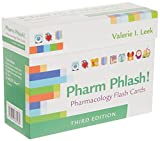
Focus on Pharmacology (8th Edition)
Focus on Nursing Pharmacology makes challenging concepts more approachable. Engaging learning features cultivate your clinical application, critical thinking and patient education capabilities. This updated 8th edition builds on your knowledge of physiology, chemistry and nursing fundamentals to help you conceptualize need-to-know information about each group of drugs.
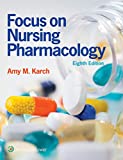
Pharmacology Made Incredibly Easy (Incredibly Easy! Series®)
Nursing pharmacology guide offers step-by-step guidance so you can grasp the fundamentals in enjoyable Incredibly Easy style. This is the perfect supplement to class materials, offering solid preparation for NCLEX® as well as a handy refresher for experienced nurses. Colorfully illustrated chapters offer clear, concise descriptions of crucial nursing pharmacology concepts and procedures.
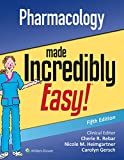
Lehne’s Pharmacology for Nursing Care (11th Edition)
The Eleventh Edition of Lehne’s Pharmacology for Nursing Care provides a thorough understanding of key drugs and their implications for nursing care. This text, written by renowned nursing educators, helps you comprehend and apply pharmacology principles. A clear and engaging writing style simplifies complex concepts, making even the most challenging pharmacology content enjoyable. We recommend this book if you want a comprehensive nursing pharmacology guide.
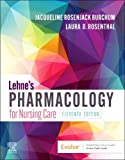
Nursing Drug Handbook
Nursing2023 Drug Handbook delivers evidence-based, nursing-focused drug monographs for nearly 3700 generic, brand-name, and combination drugs. With a tabbed, alphabetical organization and a “New Drugs” section, NDH2023 makes it easy to check drug facts on the spot.
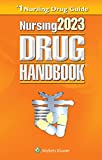
Pharmacology and the Nursing Process
The 10th edition of Pharmacology and the Nursing Process offers practical, user-friendly pharmacology information. The photo atlas contains over 100 unique illustrations and photographs depicting drug administration techniques. Updated drug content reflects the most recent FDA drug approvals, withdrawals, and therapeutic uses.
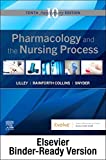
Mosby’s Pharmacology Memory NoteCards: Visual, Mnemonic, and Memory Aids for Nurses
The 6th edition of Mosby’s Pharmacology Memory NoteCards: Visual, Mnemonic, & Memory Aids for Nurses incorporates illustrations and humor to make studying easier and more enjoyable. This unique pharmacology review can be utilized as a spiral-bound notebook or as individual flashcards, making it ideal for mobile study.
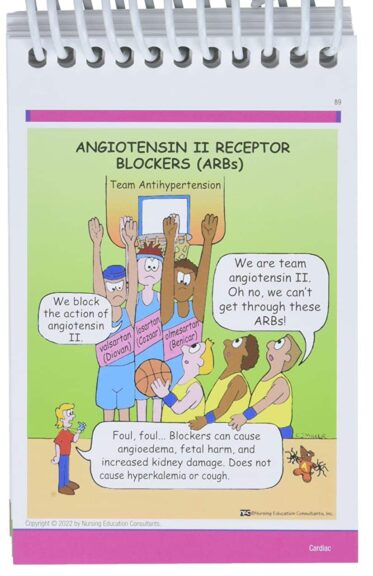
See Also
Here are other nursing pharmacology study guides:
- Nursing Pharmacology – Study Guide for Nurses
Our collection of topics related to nursing pharmacology - Pharmacology Nursing Mnemonics & Tips
These nursing mnemonics aim to simplify the concepts of pharmacology through the use of a simple, concise guide. - Generic Drug Name Stems Cheat Sheet
Learn about these generic drug name stems to help you make sense of drugs easier! - Common Drugs and Their Antidotes
A guide to drug antidotes that nurses should be familiar about. - IV Fluids and Solutions Guide & Cheat Sheet
Get to know the different types of intravenous solutions or IV fluids in this guide and cheat sheet. - Drug Dosage Calculations NCLEX Practice Questions (100+ Items)
Care to take the challenge? This quiz aims to help students and registered nurses alike grasp and master the concepts of medication calculation.
Drug Guides NEW!
Individual drug guides and nursing considerations for the most common medications used in nursing pharmacology:
- Acetaminophen (Tylenol)
- Aspirin
- Atorvastatin (Lipitor)
- Enoxaparin (Lovenox)
- Furosemide (Lasix)
- Gabapentin
- Hydromorphone (Dilaudid)
- Lisinopril
- Metoprolol
- Morphine
Gastrointestinal System Drugs
Respiratory System Drugs
- Antihistamines
- Bronchodilators and Antiasthmatics
- Decongestants
- Expectorants and Mucolytics
- Inhaled Steroids
- Lung Surfactants
Endocrine System Drugs
- Adrenocortical Agents
- Antidiabetic Agents
- Glucose-Elevating Agents
- Hypothalamic Agents
- Insulin
- Parathyroid Agents: Bisphosphonates, Calcitonins
- Pituitary Drugs
- Sulfonylureas
- Thyroid Agents
Autonomic Nervous System Drugs
- Adrenergic Agonists (Sympathomimetics)
- Adrenergic Antagonists (Sympatholytics)
- Anticholinergics (Parasympatholytics)
- Cholinergic Agonists (Parasympathomimetics)
Immune System Drugs
Chemotherapeutic Agents
- Anthelmintics
- Anti-Infective Drugs
- Antibiotics
- Antifungals
- Antineoplastic Agents
- Antiprotozoal Drugs
- Antiviral Drugs
Reproductive System Drugs
Nervous System Drugs
- Antidepressants
- Antiparkinsonism Drugs
- Antiseizure Drugs
- Anxiolytics and Hypnotic Drugs
- General and Local Anesthetics
- Muscle Relaxants
- Narcotics, Narcotic Agonists, and Antimigraine Agents
- Neuromuscular Junction Blocking Agents
- Psychotherapeutic Drugs
Cardiovascular System Drugs
References and Sources
References and sources for this pharmacology guide for Cholinergic agonists:
- Karch, A. M., & Karch. (2011). Focus on nursing pharmacology. Wolters Kluwer Health/Lippincott Williams & Wilkins. [Link]
- Katzung, B. G. (2017). Basic and clinical pharmacology. McGraw-Hill Education.
- Lehne, R. A., Moore, L. A., Crosby, L. J., & Hamilton, D. B. (2004). Pharmacology for nursing care.
- Smeltzer, S. C., & Bare, B. G. (1992). Brunner & Suddarth’s textbook of medical-surgical nursing. Philadelphia: JB Lippincott.
